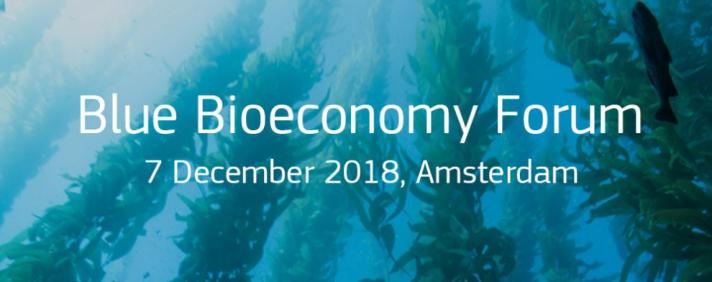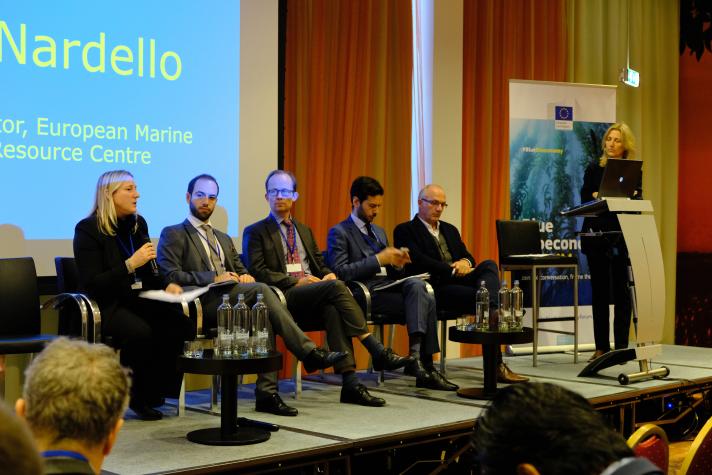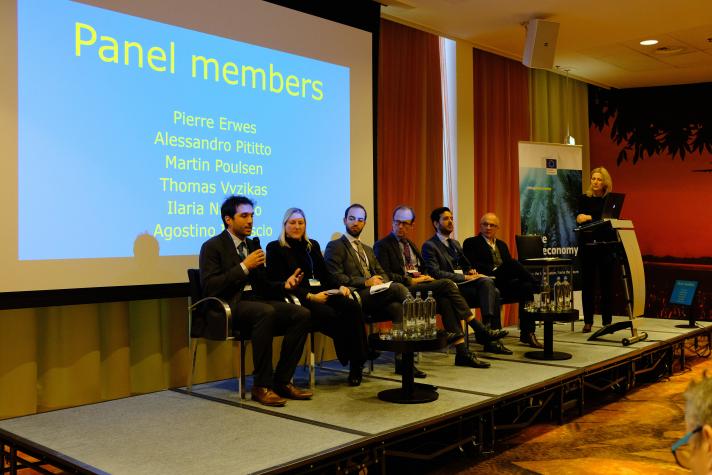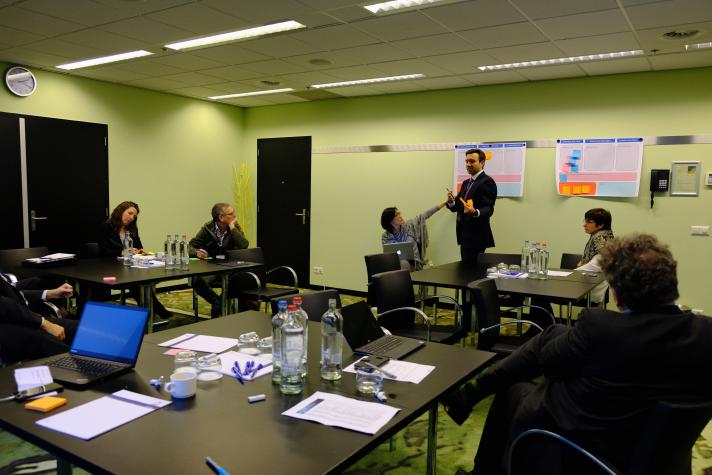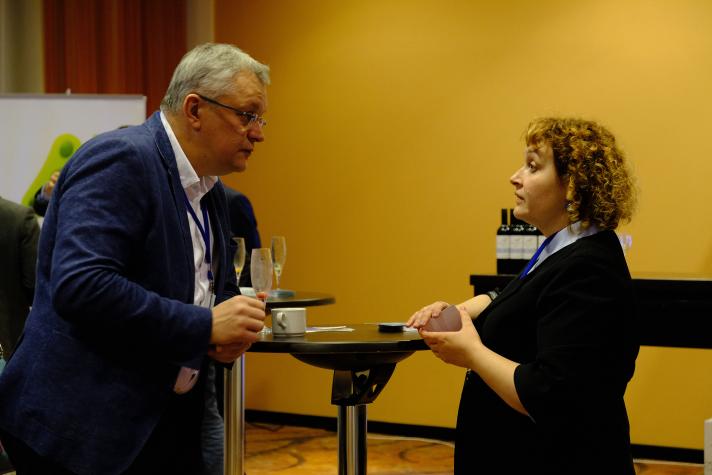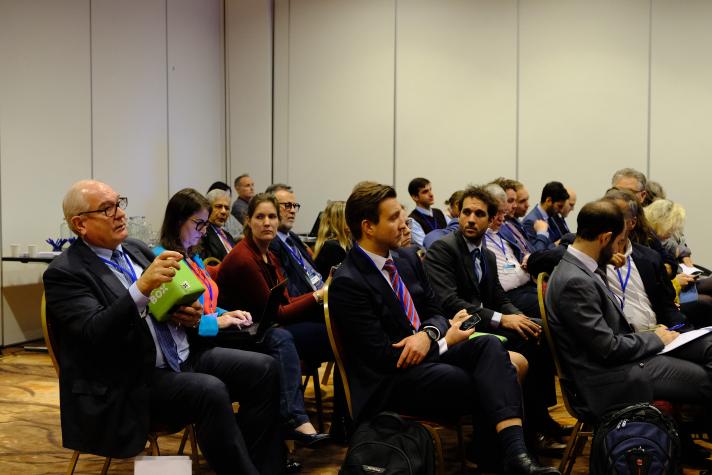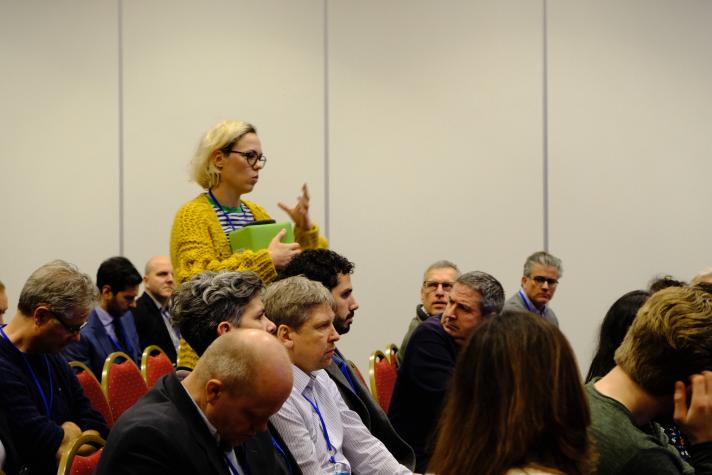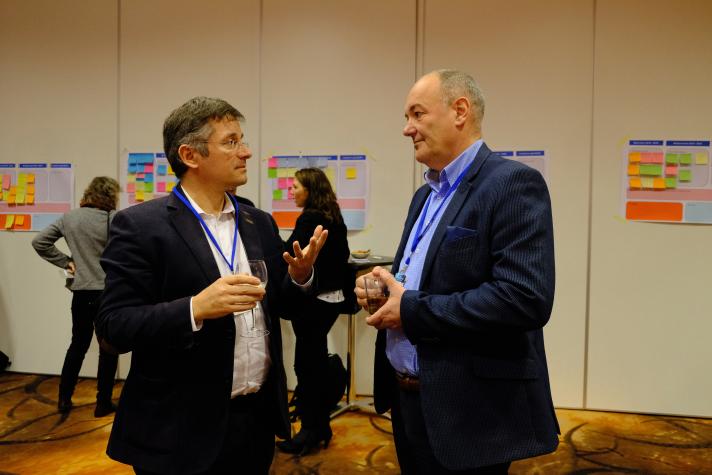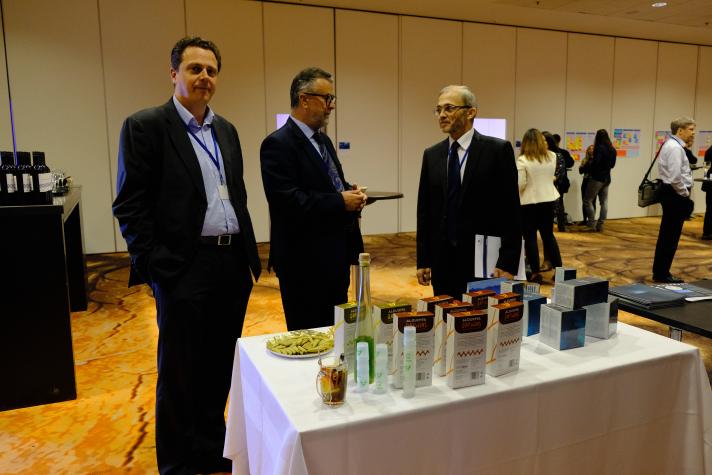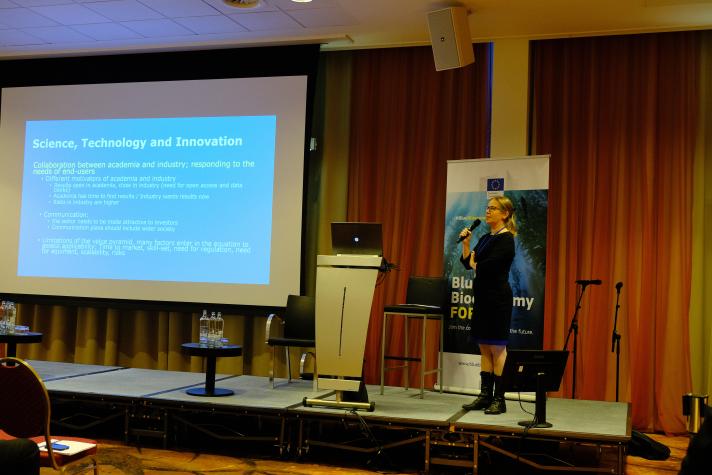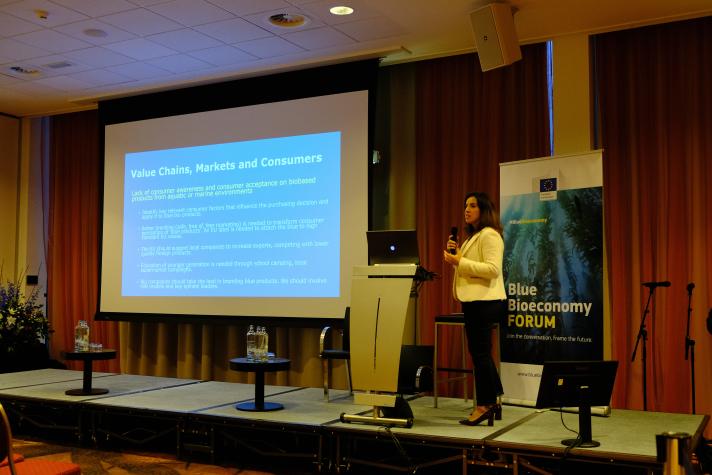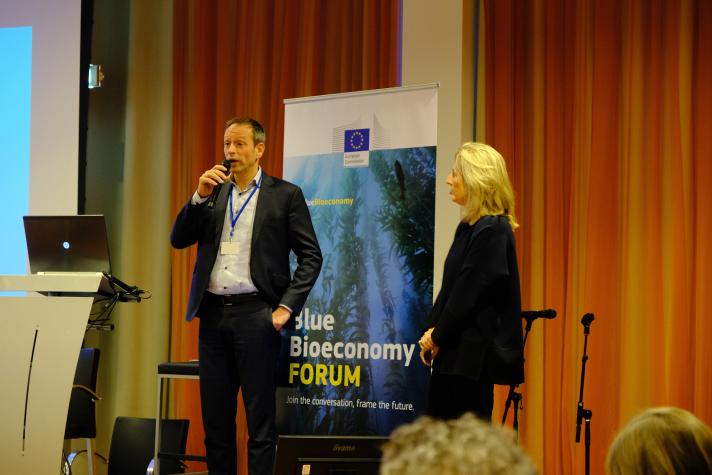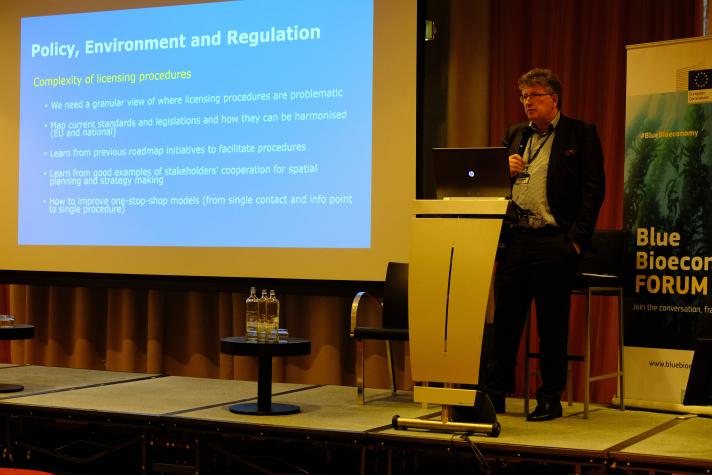x
“If you want to go fast, go alone. If you want to go far, go together.” This African proverb was borrowed by a panellist at the First Blue Bioeconomy Forum (BBF) Conference hosted by the European Commission to illustrate the importance of working together on a clear and robust roadmap charting Europe’s future in this diverse and dynamic sector. The scientists, entrepreneurs, policy-makers and financiers attending the 7 December event in Amsterdam needed no convincing that cooperation is vital, as the complexity of the task unfolded.
Vitor Verdelho, president of European Algae Biomass Association and member of the BBF Steering Committee set the scene: “We are not looking for one big idea but a cluster of interesting possible ideas to help the Blue Bioeconomy Forum lay down a roadmap in the framework of what Europe wants in the sector.” Everything from robust definitions and formal mechanisms (standards, licensing, labelling, regulations, etc.) to new business and leadership models to addressing data, research, personnel and infrastructure challenges, and setting suitable priorities and milestones to help the sector flourish.
Bernard Friess, who is director of European Commission’s Maritime Affairs and Fisheries Directorate General, underscored this mission in his welcome statement. The BBF, he said, is tasked with exploring how to stimulate this dynamic sector, and to provide practical proposals, including the technical and funding elements, to take it forward. He gave some background on the EU’s Bioeconomy Strategy and the need to mobilise more maritime resources in achieving European and global commitments to renewables (Energy Union), climate change (Paris Agreement) and sustainable development (SDGs).
x
The ‘blue impact’ zone
The first panellist, BioMarine’s executive chairman Pierre Erwes, talked about the untapped potential of low trophic species for the blue bioeconomy, which deserve more attention and capital. However, just like most ventures in the Blue Bioeconomy, innovative projects struggle through what he and others in the panel called the “valley of death”, where growth funds dry up. His organisation has just launched the Blue International Coop, which already counts 23 signatory countries, and the Blue Bioplastic Consortium, both as springboards for the sector. He spoke of the need to rethink investment models and strategies for high-risk, marine-based businesses. A new fund he is building pitches banks, the corporate sector… anyone “interested in ‘blue impact’ and sustainable issues” anywhere in the world. The plan with the Blue Forward Fund is to invest €200 million in some 17 projects with two or three funding rounds of up to € 20 million for pre-commercial and commercial ventures, to help Europe’s start-ups and established small businesses get through the ‘valley’.
Public-private partnerships are another way out of the valley, suggested Thomas Vyzikas from the Bio-Based Industries Joint Undertaking (BBI-JU) which has EU backing of €3.7 billion and €2.7 billion “in kind” from industry at its disposal for promising aquatic biomass projects – a 2018 call has already yielded seven projects, one of which (BioSea) has reach demo stage.
Panellist Alessandro Pititto introduced a new report he worked on for the EUMOFA ( European Market Observatory for Fisheries and Aquaculture products) and lamented the “wasted opportunities”, literally, in fish biomass beyond low-value fish meal by-products. We need an “everything but the oink” approach, he said, using every bit of the fish, crustacean and shellfish in a range of food, feed, cosmetic, nutraceutical and other innovative applications. “It’s stupid not to use it and extract much more value from things we’re not using.” This calls for technological innovation in processing and storage, and a better policy framework to integrate value chains of traditional (fisheries) and novel biomass uses. He also called for richer information and data specifications covering different species and activities, and showed an interactive ‘geo-mapped’ portal (EMODNET- European Marine and Observation Network) of European activity in marine-based businesses, with micro- and macroalgae facilities recently added. “It’s still not perfect, but we will add more detail on the species level later,” he said.
x
Finance, the elephant in the room
During the break, BBF News spoke with Nuno Leiti, a young entrepreneur from SEAentia in Portugal about his expectations of the day. “We are a small start-up so, for us, the biggest challenge is accessing finance with little collateral or history in the sector,” he explained. “We came to this event to understand different perspectives and see if we’re approaching it the right way, asking the right questions; there are some hidden hurdles we know about: for example, we have access to EU funds but only on reimbursement basis, so we first have to find the money from somewhere else.”
Delegates were waiting to hear what Martin Poulsen, managing director of Acacia Sustainable Business Advisors and member of the Blue Economy Investment Study team, had to say about tricky financial aspects, the proverbial elephant in the room. The main barriers, he reiterated, include the valley of death, and how to mobilise capital in the bioeconomy, but also a clear lack of sector knowledge. “It’s just not mainstream yet!” Many great ideas are emerging out of public-supported programmes in Europe, but raising finance for prototyping and scaling these up remains a problem. He said SMEs with proven access to technical assistance are generally more attractive to risk-averse private investors.
Research underpins the blue bioeconomy, according to panellist Ilaria Nardello from the European Marine Biological Resource Centre (EMBRC-ERIC) who stressed the important relationship between industry and science “at the heart of spinning innovation” in the marine bioeconomy, the “ultimate inner frontier” with a wealth of potential biomaterials to develop in a sustainable way. But much more investment in research infrastructure and better data are needed. She called for a repository – a “body of knowledge on marine organisms” – to be created, including not just species and physical or geographic nature, but also their potential uses and what risks (properties) are involved in using them. Scientists should play a deeper role in “growing innovative businesses”, she suggested, to “create some magic”.
Agostino Inguscio from the Commission’s Research & Innovation Directorate General’s Marine Resources Unit spoke about the recently updated Bioeconomy Strategy and its links to the day’s activities, but also to wider EU goals, as stressed by President Junker in his latest State of the Union speech. “Forums like this are critical,” he said, in delivering on the Strategy, connecting science and people on the ground, driving innovation towards tangible products and markets. He reminded delegates of the new Horizon 2020 "Cofund" project on the blue bioeconomy and imminent call worth €32 million (€7-8 million from the EU).
With the scene-setting panel session over, conference moderator Simone Brummelhuis of TheNextWomen introduced the ensuing themed workshops as an opportunity to cast fresh light on this emerging field, identify skills gaps and hurdles, explore new approaches and models, and establish actionable priorities to forge a robust blue bioeconomy roadmap for Europe.
x
BBF Working Groups: charting the way…
Participants at the the First Blue Bioeconomy Forum Conference were well briefed ahead of the themed working groups: Policy, environment and regulation (WG1); Finance and business development (WG2); Value chains, markets and consumers (WG3); and Science, technology and innovation (WG4). Workshop facilitators and rapporteurs made sure the key messages were gathered after two rounds of discussions and they were presented to the whole delegation at the end of the day.
x
Highlights of the two WG1 sessions included the need for a more “granular view” where licensing procedures are notably tricky, but also a broader overview of current standards and legislation and how they can be harmonised at EU and national levels. The group urged BBF to learn from previous roadmap initiative and examples, and to strengthen one-stop-shop models for licensing. The group called for concrete environmental targets and rewards (i.e. payment schemes) for blue bioeconomy activities that provide ecosystem services (by putting a price on maritime activities that lead to environmental degradation) to be defined and integrated into legislation.
Participants in WG2 prioritised clear milestones to divide up investment time lines with value creation milestones towards their exit strategy. “These ‘inflection points’ are not clear in a young industry like this,” said finance expert and BBF member Wilco Schoonderbeek who moderated the session. More focus on management skills, awareness and a common language for investment in the sector would improve “investment readiness” and capital-raising activities, effectively creating an “assembly line” for building great companies.
The WG3 sessions called for much better branding and awareness campaigns (schools and supermarkets) to transform consumer perception and establish a “premium brand”. More EU support for local companies to increase exports and compete with foreign products would be welcomed, but big companies should take the lead and target market influencers. On ‘valorising’ side streams, public incentives and infrastructure co-investment is needed (e.g. biorefineries, logistics). Research, data and new business models should be developed to meet consumer and market demands, but also to engage investors. A one-stop-shop for regulatory advice is recommended to help researchers and start-ups identify hurdles much earlier.
Highlights from WG4 included calls for more open access data banks and better communication to bridge awareness gaps between science, industry and society. The group identified several “value pyramid” limitations affecting speed to market, scalability, research infrastructure, skills and equipments, and the role of regulation. Researchers need to contribute more to scaling-up efforts, and industry should be more involved at earlier stages of the innovation pipeline. Ecosystem services need to be included in business models earlier, and a demand-driven view would help to identify which oil-based products can be replaced first, and what is needed for that. Here, a greater emphasis on “gateway” projects and coordinated interdisciplinary activities (based on strong relationships and communication between academia and industry) to help scale up infrastructure are desirable, the group concluded.
x
Blue bioeconomy, from ‘potential’ to ‘potent’ force in Europe
A dynamic sector with “huge potential”, a “game-changer” for sustainable business, a “pioneering sector”… these and other statements made during the event suggest that the blue bioeconomy is a nascent concept. But several entrepreneurs at the First Blue Bioeconomy Forum Conference begged to differ. “There has been a lot of discussion about the blue bioeconomy’s ‘potential,’ but as you see by our products on this table, it’s already real for us. We develop marine microalgae (Chlorella vulgaris) into a range of products, from hard bread to high-value cosmetics, nutraceuticals, creams, etc.,” pointed out Manuel Tarraga who is project development director of Alguimya. “Yes, it is early days for the sector in Europe, but it has a long history in other places like Asia. We are part of a small set of companies in the sector, and we need support or facilities to ensure a sustainable supply of raw materials that meet EU standards.”
x

